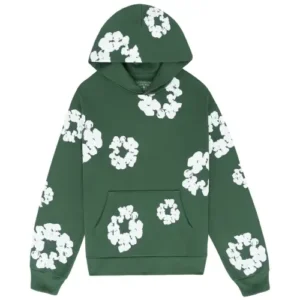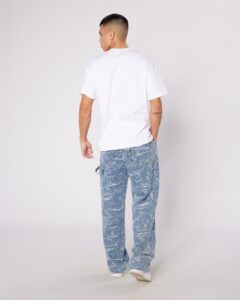Denim Tears Hoodie: The Intersection of Fashion, Culture, and Heritage
In the ever-evolving Denim Tears world of streetwear and high fashion, there are few items that carry as much cultural weight and significance as the Denim Tears hoodie. A symbol of both luxury and authenticity, this unique piece of fashion has transcended its original purpose to become a marker of identity, culture, and storytelling. From the streets to the runway, the Denim Tears hoodie has garnered attention for its innovative designs and the powerful narratives it evokes. But what exactly makes this hoodie so special? Let’s explore the roots of Denim Tears, the design elements that set the hoodie apart, and the cultural impact it has had.
The Birth of Denim Tears
Before we delve into the significance of the Denim Tears hoodie, it’s important to understand the brand behind it. Denim Tears was founded by Tremaine Emory, a creative force who has long been at the forefront of the intersection between fashion, art, and cultural commentary. Emory’s background in graphic design and his deep ties to the hip-hop scene allowed him to bring a unique perspective to the world of fashion.
The brand first gained significant attention with its collection that centered around the theme of denim, a fabric that holds deep historical roots in American culture. Denim, of course, is synonymous with hard work, rebellion, and blue-collar life in America, but Denim Tears was able to elevate this fabric into a medium for storytelling. By blending the raw, ruggedness of denim with culturally relevant narratives, Denim Tears became more than just a brand—it became a voice for marginalized communities and a platform to discuss issues of race, history, and identity.
A Hoodie Like No Other
The Denim Tears hoodie is a testament Denim Tears Hoodie to the brand’s ability to blend aesthetics with meaning. While a hoodie is typically considered a basic garment, Emory’s approach to this everyday piece of clothing elevates it to a work of art. From the choice of materials to the intricate design details, every element of the Denim Tears hoodie is meticulously crafted to convey something deeper than just fashion.
The Denim Fabric: A Nod to Heritage
One of the standout features of the Denim Tears hoodie is the prominent use of denim fabric. Denim has always been a symbol of resilience and working-class culture, and its inclusion in the hoodie design is a nod to these historical associations. However, Denim Tears doesn’t simply use denim in a conventional way. Emory reimagines the fabric, giving it a new cultural context by incorporating elements that reflect African-American history and heritage. The choice of denim as a central material is symbolic—it represents the foundation upon which the brand is built and reinforces the story of strength, survival, and rebellion against systemic oppression.
Graphic Prints and Imagery
In addition to the denim material, another key feature of the Denim Tears hoodie is the graphic prints and imagery that adorn the garment. Denim Tears often features powerful and thought-provoking graphics, including references to slavery, civil rights, and the African-American experience. These visuals are a deliberate choice by Emory, who uses fashion as a vehicle to address and challenge social issues. The imagery on the Denim Tears hoodie speaks to the brand’s commitment to using fashion as a tool for storytelling and activism.
One of the most iconic prints featured on the Denim Tears hoodie is the cotton flower motif. This design is a direct reference to the history of slavery in America, as cotton was a primary crop cultivated by enslaved Black people. By incorporating this symbol into his designs, Emory seeks to acknowledge this painful history while simultaneously reclaiming the narrative and celebrating the resilience of Black Americans.
Comfort Meets Luxury
While the Denim Tears hoodie is undoubtedly a Denim Tears Shirts statement piece, it doesn’t sacrifice comfort for style. One of the reasons this hoodie has resonated so strongly with fashion enthusiasts is its perfect balance of luxury and wearability. The material used is soft yet durable, making it suitable for everyday wear, while the fit is both relaxed and stylish, offering a timeless silhouette.
In the world of streetwear, comfort is key, and the Denim Tears hoodie delivers in this regard. It’s not just a piece for display; it’s designed to be worn and enjoyed in everyday life. Whether paired with jeans, sweatpants, or even layered over a t-shirt, the hoodie serves as a versatile garment that can be styled in a variety of ways.
Cultural Impact: A Voice for the Voiceless
The Denim Tears hoodie goes beyond its status as a fashion statement; it serves as a means of expression, allowing the wearer to connect with the cultural themes that are central to the brand’s identity. Through his designs, Tremaine Emory has successfully created a platform for marginalized voices, using his clothing to speak on issues such as racial inequality, social justice, and historical awareness.
A Symbol of Black Empowerment
The Denim Tears hoodie has become a symbol of Black empowerment, as it addresses themes related to the African-American experience while also celebrating Black culture. Emory has been praised for using his platform to highlight issues such as systemic racism, police brutality, and the legacy of slavery, all while producing a product that is both fashionable and meaningful.
The graphic designs featured on the hoodie, particularly the cotton flower motif, act as a conversation starter—prompting wearers and onlookers to reflect on the painful history of slavery while also recognizing the strength and resilience of the Black community. By reclaiming the imagery associated with cotton, Denim Tears challenges the oppressive associations of the past, transforming it into a symbol of pride and cultural endurance.
A Movement, Not Just a Brand
What sets Denim Tears apart from Denim Tears Sweatshirt other fashion brands is its ability to create a movement rather than just a product. Through the Denim Tears hoodie, Emory has managed to create a space where fashion, art, and social commentary converge. It’s not just about wearing a hoodie; it’s about wearing a piece of history, a statement of resilience, and a call for change.
The hoodie has been embraced by celebrities, influencers, and activists alike, further solidifying its position as a cultural touchstone. When prominent figures wear Denim Tears, they are not just promoting a brand—they are endorsing a message of empowerment, unity, and resistance. In this way, the Denim Tears hoodie serves as both a personal statement and a collective rallying cry.
The Future of Denim Tears
As Denim Tears continues to gain traction in the fashion industry, the future looks bright for the brand and its iconic hoodie. With its focus on heritage, culture, and social change, Denim Tears is poised to remain a force within both streetwear and high fashion. Emory’s ability to tap into the zeitgeist and create designs that resonate with contemporary issues ensures that Denim Tears will remain relevant for years to come.
The Denim Tears hoodie will undoubtedly continue to evolve, incorporating new design elements and exploring fresh narratives, but one thing is certain: it will always remain grounded in the rich history and cultural significance that has made it such an important piece in the fashion world.
Conclusion
The Denim Tears hoodie is more than Denim Tears Sweatpants just a piece of clothing; it’s a symbol of cultural resilience, a conversation starter, and a statement of empowerment. By blending streetwear with deep historical and social themes, Tremaine Emory has created a brand that resonates on a profound level with people of all walks of life. Whether you’re wearing it for its stylish appeal or for the cultural narrative it carries, the Denim Tears hoodie is undeniably a piece of fashion history in the making. As the brand continues to push boundaries, it will undoubtedly inspire future generations to use fashion not just as a form of self-expression but as a powerful tool for change.






